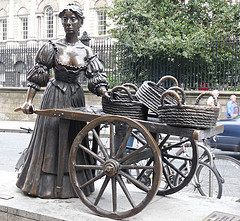2.1 Irish National Anthem
Conocimiento previo
|
|
Have you realized the title of the unit? Amhrán na bhFiann
This is the name of the Irish National Anthem. The original English lyrics are called The song has three verses, but the national anthem consists of the chorus only. Look at the lyrics of the chorus below. You can compare both |
While watching the video below you can try to sing the Irish version!!!
|
IRISH VERSION Amhrán na bhFiann
|
ENGLISH VERSION The Soldiers' song
|
|
Sinne Fianna Fáil |
Soldiers are we, whose lives are pledged to Ireland, Some have come from a land beyond the wave, Sworn to be free, no more our ancient sireland, Shall shelter the despot or the slave. Tonight we man the "bearna baoil", In Erin’s cause, come woe or weal, ’Mid cannon’s roar and rifles’ peal, We’ll chant a soldier's song |
SOURCE:http://en.wikipedia.org/wiki/Amhr%C3%A1n_na_bhFiann#cite_note-43
Rellenar huecos
 Imagen de faraz_memon en Flickr bajo licencia CC |
Dublin has produced many fine songs but none has become as closely associated with the city as Molly Malone which is considered to be the UNOFFICIAL ANTHEM for Dublin City. It is also known as Dublin's Fair City or Cockles and Mussels.
The statue on the left is Molly Malone, a must-see attraction which stands in Dublin's Grafton Street. In the text below you will learn more about this woman. Match the titles below to the corresponding paragraph and write the number in the space provided:
|
While reading the lyrics in the video, you can check the information provided in the text above about Molly Malone:
